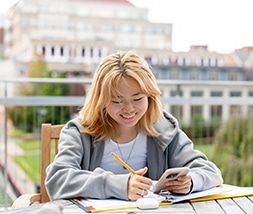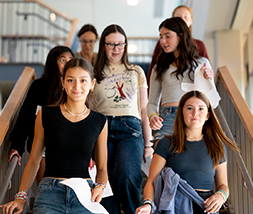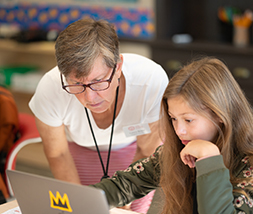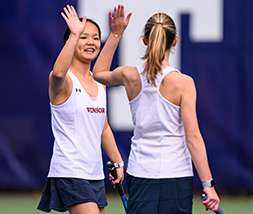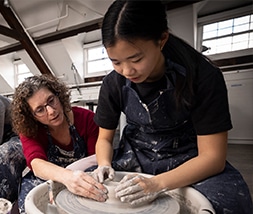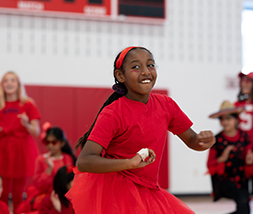Curriculum Guide
Performing and Visual Arts
Students must complete 1.25 credits of performing and/or visual arts by the middle of Class VIII, with at least 0.75 credits completed by the end of Class VI. In order to fulfill the arts requirement for graduation, students must engage in hands-on creative pursuits and the process of creating; therefore students will earn academic rather than arts credit for Intellectual Property and the Law and History of Art. When choosing performing and visual arts electives, please be sure to indicate first, second, and third choices for each semester during which you would like to take arts.
Please refer to the following tables to see which courses are open to each grade level. All courses that are asterisked have a prerequisite or require an audition/permission from the instructor. Full course descriptions are listed by department, directly after the tables.

Visual Arts Minor Electives
While the arts requirement is 1.25 credits, Visual Arts courses are mostly 0.5-credit intensive minor courses. Second-semester sophomores, juniors, and seniors who have fulfilled the prerequisites may choose to take Advanced Portfolio Development as a 0.25 or 0.5 credit minor course.
Advanced Drawing and Painting (0.5 credits, fall)
In this studio, students will approach painting both traditionally and more experimentally in oils and other media while exploring a wide array of subjects and techniques. Throughout the semester, students are expected to pursue the development of a personal style of expression and a command of both technical and conceptual means in drawing, painting, and mixed media. Some experience with painting, while not required, is helpful. Open to students in Classes VI–VIII. Prerequisite: Drawing Studio or Painting Studio, or permission of the instructor.
Advanced Portfolio Development (0.25 or 0.5 credits, fall and/or spring)
Advanced Portfolio Development is intended for advanced and motivated students who have already shown a serious commitment in art, already have familiarity with the techniques, processes and ideas that they intend to use, have taken a number of Upper School art electives and who are prepared to work intensively to develop a body of work which could be submitted as an art portfolio or supplement to their college application. Alternatively, this studio offers the opportunity for students to work intensively from a live model in order to develop the tools needed to draw and paint the human form. Interested students should reach out to the department head about the proposal guidelines and process for the course. The submission and approval of a proposal is required for enrollment in this course. Open to students in the second semester of Classes VI or in Classes VII–VIII. Prerequisite: Two semesters of visual art electives or the equivalent, and permission of the instructor and the head of the Visual Arts Department.
Ceramics: Hand Building (0.5 credits, fall)
This course will focus on several different handbuilding techniques including pinch, slab, coil, and paddle. The aesthetics of form and surface will be the principal focus throughout the course as students learn about different traditions of functional clayware from ancient to contemporary times, and focus on developing craftsmanship and their own personal style of expression. The main goal of the course is to develop a creative understanding of ceramic forms and processes, including the use of various tools and glazing techniques. Assignments will focus on three-dimensional form, functionality, scale, surface texture, good craftsmanship, and glazing. Open to students in Classes V–VIII.
Ceramics: Wheel Throwing (0.5 credits, spring)
This course will focus on the development of the basic techniques and skills needed for throwing on the potter’s wheel. Students will learn to center clay, to throw cylinders, bowls, and plates, and to trim and finish the bases of their pieces. Treatments that enhance the form and function of a thrown piece will be explored, including added handles, formed spouts, surface texture, and hand altering the overall shape. The main goal of the course is to develop a creative understanding of ceramic forms and processes, including the use of various tools and glazing techniques. Students will develop a practice that focuses on three-dimensional form, functionality, scale, surface texture, good craftsmanship, and glazing. Open to students in Classes V–VIII. Prerequisite: Hand Building, starting with the Class of 2027.
Darkroom Photography: The Art of Seeing (0.5 credits, fall)
In this class, students will hone their photographers’ eye and sharpen their creative vision to make images with impact. Using a variety of film cameras, students will gain an understanding of camera skills, photographic principles, and an intentional image-making process. Students will also build a foundation of essential skills in the darkroom including how to load a camera with film, develop black and white film, and enlarge and print photographs. Open to students in Classes V–VIII.
Digital Photography: The Art of Seeing (0.5 credits, fall or spring)
In this class, students will hone their photographers’ eye and sharpen their creative vision to make images with impact. Using digital cameras, students will gain an understanding of camera skills, photographic principles, and an intentional image-making process. Students will also build a foundation of essential skills in the digital studio including fundamental Photoshop techniques for photographers. Open to students in Classes V–VIII.
Drawing Studio (0.5 credits, fall)
Drawing is a tool for visualization and description that allows us to convert our observations of three-dimensional experience into a two-dimensional record. Drawing Studio introduces drawing as a practice of observation, expression, and experimentation as well as a means of giving form to ideas. Students will learn how to articulate visual form using line, tone, pattern, texture, volume and mass, shape, and space. This class is for those who feel challenged by drawing and need more time and practice to develop their ability, and for those who have already acquired certain drawing skills but want to develop these further and more intensely. After exploring the range of approaches and media introduced in this course, students will be better suited to choose which aspects of drawing resonate most for them. Open to students in Classes V–VIII.
Film and Video: The Art of Seeing (0.5 credits, spring), not offered in the 2025–26 academic year
In this class, students will be introduced to visual storytelling, develop technical skills, and sharpen their visual awareness and appreciation for the expressive potential of the moving image. Using found footage as well as DSLR cameras, students will learn basic camera operations, editing, lighting, and post-production. In addition to making films and videos, watching and discussing films and videos will serve to introduce students to historical and contemporary film and video art and teach them to recognize different types of framing and editing techniques. Open to students in Classes V–VIII. This course will be offered next in the 2026–27 school year.
Further Explorations in Darkroom Photography (0.5 credits, fall)
Building on the technical and conceptual understanding learned in the prerequisite course, this elective is designed to challenge students to go beyond technical skills and photographic principles and to focus on production and high-quality craftsmanship of imagery in darkroom photography. Students will continue to develop their camera skills with assignments that are largely self-driven and increasingly more in-depth and conceptual. A range of tools can be used including alternative printing processes, painting with developer, mixed media, and image transferring. Students will pay special attention to ways in which their technical decisions can enhance their artistic intentions. Open to students in Classes VI–VIII. Prerequisite: Darkroom Photography: The Art of Seeing.
Further Explorations in Digital Photography (0.5 credits, spring)
Building on the technical and conceptual understanding learned in the prerequisite course, this elective is designed to challenge students to go beyond technical skills and photographic principles, and to focus on production and high-quality craftsmanship of imagery in digital photography. Students will continue to develop their camera skills with assignments that are largely self-driven and increasingly more in-depth and conceptual. A range of tools can be used in the digital studio, including working with RAW files, Photoshop, Lightroom, and large-scale color ink-jet printing. Students will pay special attention to ways in which their technical decisions can enhance their artistic intentions. Open to students in Classes V–VIII. Prerequisite: Digital Photography: The Art of Seeing.
Further Explorations in Wheel Throwing (0.5 credits, spring)
Building on the skills learned in Ceramics: Wheel Throwing, this course is designed to challenge students to go beyond the basics of centering, forming and trimming and will focus on production and high quality output of functional and/or sculptural forms. Students will refine their skills and work on vessels of different sizes, as well as experiment with surface texture and glazing techniques. Open to students in Classes VI–VIII. Prerequisite: Ceramics: Wheel Throwing.
Painting Studio (0.5 credits, spring)
Working with a wide array of media, including pastels and paint, surfaces including paper and board, and different approaches to painting, students will explore fundamental painting techniques. This studio introduces basic principles of drawing, composition, and color theory, and emphasizes direct painting in oil. Some experience with drawing, while not required, is helpful. Open to students in Classes V–VIII.
Printmaking (0.5 credits, spring)
This course is designed to give students a chance to explore several different techniques in printmaking, including additive and reductive approaches to traditional printmaking techniques as well as experimental, indirect image-making methods. Exposure to different processes and materials will give students experience in block printing, engraving, monoprinting, and woodcut, in addition to a variety of off-set transfers. Assignments will be both art- and design-based. While drawing skills are helpful, they are not necessary. Open to students in Classes V–VIII.
Sculpture (0.5 credits, fall)
This course offers an introduction to and practical experience in developing sculptural work. Students will explore additive and subtractive techniques, and a variety of tools and materials including clay, papier mache, plaster, wire, and found materials. Open to students in Classes V–VIII.
Visual Arts Major Electives
Intellectual Property and the Law, History of Art, and AP Art and Design can be taken by students in Classes VII and VIII as one of their five major courses. AP Art and Design requires the permission of the instructor and the head of the Visual Arts Department. Please refer to the table above to see the full offering of courses.
AP Art and Design (1 credit, yearlong)
AP Art and Design is intended for advanced and motivated students who have already shown a serious commitment in art, who already have familiarity with the techniques, processes, and ideas that they intend to use, who have taken a number of Upper School art electives, and who are prepared to work intensively to prepare and submit an AP Art and Design Portfolio. There are three different areas of focus for the portfolio including: AP Drawing, AP 2D Design, and AP 3D Design. Open to students in Classes VII–VIII. Prerequisite: Two semesters of full-credit art electives in the discipline(s) of anticipated portfolio work and permission of the instructor and the head of the Visual Arts Department.
History of Art (0.5 credits, spring)
In this course, students examine major forms of artistic expression from diverse cultures spanning 27,000 years and develop a contextual understanding of art history from a global perspective. Influences such as patronage, politics, class, belief systems, gender, ethnicity, and cross-cultural interactions are explored. Emphasis is placed on analytical writing and critical-thinking skills, the language of art history, and the methods used by art historians to interpret art objects. Students experience, research, discuss, and write about art, artists, and art making, supported by our regular visits to the Museum of Fine Arts. Upon completion of this course, students will have the tools to recognize important works of art and historical styles as well as to understand historical and cultural context. Open to students in Classes VII–VIII.
Intellectual Property and the Law (0.5 credits, fall)
Intellectual property law encompasses the body of law applied to fine art objects, collections, and artists. In this course, students will learn how to read and analyze legal cases. The primary focus will be on cases which discuss visual arts, including sculpture, painting, photography and film, and music. By reading and discussing case law, students will gain an understanding of relevant legal issues in the arts, including Copyright, Trademark, Fair Use, Free Speech, the Right to Privacy, the Visual Artists Rights Act, and more. Students will analyze specific cases involving intellectual property rights and the reproduction of works of art, misappropriation of artwork and design, free speech and censorship. There will be class discussions and readings about both the philosophical ideas behind the creation of specific laws, the rationale for judicial decisions, and the complexities of their practical applications to the art world. This class will be conducted as a discussion-based seminar. Assignments include written case analysis, collaborative projects, presentations, and debates, as well as assessments in which students will be asked to analyze an artwork, case, or legal document by applying the legal theories learned in class. Open to students in Classes VII–VIII.
Performing Arts Minor Electives
Dance Electives
Winsor Dance Team (0.5 credits, fall and/or spring)
Winsor Dance Team is an audition-based class for intermediate to advanced dancers and choreographers. Students will refine their technique and performance by learning repertoire from contemporary and pop cultures. They will collaborate to choreograph and produce performances for events such as the Under the Lights pep rally and assemblies. Students will also take on leadership or production roles, gaining skills in high-quality event production, including lighting, costumes, sound, and technical direction. Guest artists from diverse dance genres will be invited to teach master classes. This course requires intermediate to advanced technical, performance, or choreographic skills. Open to students in Classes V–VIII. Students may enroll in this class more than once with the permission of the instructor and head of the Performing Arts Department. Prerequisite: Audition in the late spring of 2025, or permission of the instructor and head of the Performing Arts Department.
Music Electives
Advanced Rock On (0.5 credits, spring)
Advanced Rock On is designed for experienced instrumental and vocal musicians to refine their performance skills across a variety of styles, including but not limited to rock, pop, indie, hip hop, jazz, and Latin music. Students will deepen their understanding of chord charts, tabs, and notation while working to create a dynamic, interdependent, high-level band. While students may focus on a particular instrument, including voice, they will also be encouraged to explore other instruments. Music theory will be integrated into the course. Students will take on leadership roles in song selection, rehearsals, and performance planning. The course will culminate in an all-school performance and playing before commencement. Open to students in Classes VI–VIII. Students may enroll in this class more than once with the permission of the instructor and head of the Performing Arts Department. Prerequisite: Audition in the late spring of 2025, or permission of the instructor and head of the Performing Arts Department.
Chamber Players (0.5 credits, fall)
Chamber Players is an ensemble for intermediate and advanced musicians of all instruments. There is no audition, but students will be asked to complete a brief playing evaluation at the beginning of the semester to determine their level. The course will give students an opportunity to further develop their ensemble and performance skills by playing as a full ensemble or in small chamber groups, depending on class size and instrumentation. Students will learn music from Western classical literature, folk traditions, and film scores, with an emphasis on music by women, BIPOC, and other underrepresented composers. Musicians must have proficient note-reading and technical skills on one of the following instruments: violin, viola, cello, bass, flute, oboe, clarinet, bassoon, saxophone, trumpet, trombone, euphonium, French horn, tuba, piano, or percussion (mallet instruments, and/or auxiliary percussion). Students will take a leadership role in repertoire selection, rehearsals, and performance opportunities. Open to students in Classes V–VIII. Students may enroll in this class more than once with the permission of the instructor and head of the Performing Arts Department.
Guitar Intensive (0.5 credits, fall), not offered in the 2025–26 academic year
Guitar Intensive introduces beginning students to the fundamentals of playing acoustic and electric guitar, including tuning, technique for both hands, open chords and barre chords. Using songs by artists such as Taylor Swift, Bill Withers, and The Beatles, students will learn strumming patterns and singing while playing, as well as how to express themselves through music. The course covers reading guitar diagrams, tablature, and song charts, while introducing basic music theory focused on scales, chords, and song analysis. Guitars are available for use in class, and while a guitar at home is encouraged for practice, it is not required. No prior experience is necessary. Open to students in Classes V–VIII. Students may enroll in this class more than once with the permission of the instructor and head of the Performing Arts Department. This class is on a rotation with Songwriting Explorations and Piano and will not be offered in the 2025–2026 academic year.
Illumina (1 credit, yearlong)
“Illumina” means “radiant ones” and “to give light to.” Referencing Winsor’s Lamp of Learning and the brightness of experienced voices, Illumina is Winsor’s select chorus. Singers will expand their vocal skills by learning and performing advanced repertoire from a broad range of cultures, languages, and traditions from classical to contemporary. Students need to have intermediate to advanced note-reading and technical skills. An appreciation for the complexity involved in performing music at a high level will be gained. Open to students in Classes V–VIII. Students may enroll in this class more than once with the permission of the instructor and head of the Performing Arts Department. Prerequisite: Audition in the late spring of 2025.
Intermediate Rock On (0.5 credits, spring)
For students interested in playing or singing in a rock band, Intermediate Rock On offers hands-on experience with acoustic and electric guitar, bass, drums, keys, auxiliary percussion, and lead and harmony vocals. Covering a variety of genres, the course allows students to choose some of the songs they learn. Instruction includes reading chord charts, tabs, and notation, along with basic music theory. Students will develop ensemble skills and gain confidence playing together. Intermediate Rock On has no prerequisite and does not require an audition. Open to students in Classes V–VIII. Students may enroll in this class more than once with the permission of the instructor and head of the Performing Arts Department.
Master Class for Advanced Classical Musicians (0.5 credits, spring)
Master Class is an audition-based performance course for advanced classical musicians. Students will spend the majority of class time practicing individual solo music in preparation for in-class performances for guest professional musicians. Those students who wish to may also choose to play chamber music with classmates. Students will hone their performance and audition skills, deepen their ability to interpret music from different time periods, develop strategies for more effective practice, and learn to give and receive feedback in a performance setting. In addition, students will study composers, sonata form, and relevant music theory. Master Class students will also have the option to perform at school-sponsored events, concerts, and off-campus venues. Open to students in Classes V–VIII. Students may enroll in this class more than once with the permission of the instructor and head of the Performing Arts Department. Prerequisite: Audition in the late spring or fall of 2025.
Piano (0.5 credits, fall)
This course welcomes students of all skill levels, from beginners to advanced players, and tailors instruction to their individual goals. Students will explore playing by ear, music reading, keyboard technique, music theory, and practice strategies while developing artistic expression. With teacher guidance, they will progress at their own pace, selecting genres such as classical, jazz, pop and R&B. In addition to individual instruction, students will have opportunities to collaborate in ensemble settings. Open to students in Classes V–VIII. This class is on an annual rotation with Songwriting Exploration and Guitar Intensive.
Songwriting Exploration (0.5 credits, fall), not offered in the 2025–26 academic year
In Songwriting Exploration, students will experiment with lyric writing and music composition. They will analyze iconic songs to explore song form, arrangement, and instrumental accompaniment. Working independently or in small groups, students will write multiple original songs. Using Winsor’s extensive instrument inventory, they will accompany their work on ukulele, acoustic and electric guitar, piano, or digital tools for arranging and beat-making. Students will also use digital audio workstations (DAWs) like GarageBand to record and produce multi-track versions of their songs. Musicians of all experience levels are welcome.Open to students in Classes V–VIII. This class is on a rotation with Guitar Intensive and Piano and will not be offered in the 2025–26 academic year.
A Cappella* (0.5 credits, fall)
In A Cappella, students will sing contemporary songs in various styles, such as pop, Disney, jazz, and R&B. They will develop tone, breath control, pitch, harmonization, and sight-reading skills while refining their ability to blend and harmonize within an ensemble. Students will have opportunities to perform as soloists, in small groups, and as a full ensemble, with live accompaniment or fully produced backing tracks. Throughout the term, they will showcase their work in informal performances, culminating in a final presentation.Open to students in Classes V–VIII. Students may enroll in this class more than once with the permission of the instructor and head of the Performing Arts Department. Prerequisite: Audition in the late spring of 2025.
Theater Electives
Acting Studio (0.5 credits, fall)
Students will be introduced to the fundamental building blocks of acting: objectives, obstacles, tactics, stakes, creating a character, and using the voice and body effectively onstage. We will use A Practical Handbook for the Actor to create specific, exciting scenes and vibrant, well-drawn characters. Students will learn various approaches and methods used by different, well established acting teachers, including Meisner, Adler, and Strasberg. We will be creating improvised solo work as well as working in pairs on selected contemporary scenes. Learning proper stage vocabulary and how to critique fellow actors’ work as well as local professional productions will be a major part of the course. Open to students in Classes V–VIII.
Directing (0.5 credits, fall)
Students will explore staging, communication, original scenarios and short scenes from the perspective of both the actor and director in an extremely “hands on” experience. We will use Katie Mitchell’s The Director’s Craft to explore how to approach the text in a play. Students will be introduced to several aspects of directing, including script analysis, talking to actors, staging a scene effectively, creating a concept, and rehearsal management. Each student will have the opportunity to direct student actors in scenes as well as to continue their own acting training by rehearsing and performing in other students’ directing projects. Open to students in Classes VI–VIII. Prerequisite: Acting Studio or Making a Scene, or permission of the instructor and head of the Performing Arts Department. This class is on a rotation with Musical Theater and Words & Weapons.
Making a Scene (0.5 credits, spring)
This class is for students who would like to explore several different styles and genres of theater through the preparation and performance of a variety of scenes throughout the semester. Students will be exposed to a range of plays by major playwrights and will cover realistic drama, absurdism, farce, and classical theater while also incorporating script analysis, character development, and multiple acting approaches. We will use Jory’s Teaching the Actor Craft text to explore various exercises and coaching tips for more effective performance, as well as Shurtleff’s book Audition to explore the Twelve Guideposts of Acting. Learning proper stage vocabulary and how to critique fellow actors’ work will also be a major part of the class. Taking Acting Studio is strongly recommended but not required. Open to students in Classes V–VIII.
Musical Theater (0.5 credits, fall), not offered in the 2025–26 academic year
Students will study the origins of American musical theater from operetta and vaudeville, through the “Golden Age” and the “British invasion” to contemporary Broadway musicals. Students will have the opportunity to study and perform scenes, songs, and musical numbers from a variety of styles. We will learn how to act a song, learn how to transition from dialogue to song, and learn the specific functions of each type of song in a show’s structure. Although there is some singing involved, it is not the main focus of the class! Open to students in Classes VI-VIII. Prerequisite: Acting Studio or Making a Scene, or permission of the instructor and head of the Performing Arts Department. This class is on a rotation with Words & Weapons and Directing and will not be offered in the 2025–26 academic year.
Technical Theater (0.5 credits, fall)
In this course, students will be introduced to theater principles through an exploration of lighting, set, and sound. This will include learning how to operate the sound and light boards, how to use a variety of tools in the scene shop, and how to use different painting techniques. The students will practice their skills by running assemblies and concerts during the school day. A requirement of this course, and in lieu of homework, is that students must commit to being on the tech crew for one production, which generally includes five afterschool tech days and two evening performances. Students may choose from four different productions that run throughout the semester. Schedules for these required responsibilities will be determined at the beginning of the semester. Open to students in Classes V–VIII. Students may enroll in this class more than once with the permission of the instructor and head of the Performing Arts Department.
Theater Design (0.5 credits, spring)
In this course, students will deepen their knowledge of technical theater by exploring the choices behind lights placement, the use of acoustic shells, and theories behind design work. Students will learn the fundamentals of manipulating stage mechanisms for productions as well as create their own set, light, and sound designs. In addition, students will practice running shows in a professional manner while collaborating as backstage crew members. A requirement of this course, and in lieu of homework, is that students must commit to being on the tech crew for one production, which generally includes five afterschool tech days and two evening performances. Students may choose from four different productions that run throughout the semester. Schedules for these required responsibilities will be determined at the beginning of the semester. Open to students in Classes V–VIII. Students may enroll in this class more than once with the permission of the instructor and head of the Performing Arts Department.
Words & Weapons (0.5 credits, fall), not offered in the 2025–26 academic year
Students will have the opportunity to explore the use of both hand to hand and armed combat skills in conjunction with text, allowing for the chance to perform high stakes, emotional scenes that also involve complex physical movement. We will also explore “the actor as athlete,” or the idea that an actor should be trained and ready to engage safely at a high physical level onstage. The class will culminate with several famous combat scenes from Shakespeare, from a sword fight to a full-scale battle scene, with a focus on maintaining the integrity of the text, while also fully physicalizing the demands of the scene. Open to students in Classes VI–VIII. Prerequisite: Acting Studio or Making a Scene, or permission of the instructor and head of the Performing Arts Department. This class is on a rotation with Musical Theater and Directing and will not be offered in the 2025–26 academic year.
